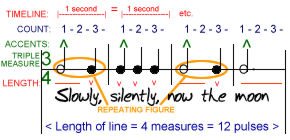Related Research Articles
Funk is a music genre that originated in African American communities in the mid-1960s when musicians created a rhythmic, danceable new form of music through a mixture of soul, jazz, and rhythm and blues (R&B). It de-emphasizes melody and chord progressions and focuses on a strong rhythmic groove of a bassline played by an electric bassist and a drum part played by a percussionist, often at slower tempos than other popular music. Like much of African-inspired music, funk typically consists of a complex groove with rhythm instruments playing interlocking grooves that create a "hypnotic" and "danceable" feel. Funk uses the same richly colored extended chords found in bebop jazz, such as minor chords with added sevenths and elevenths, or dominant seventh chords with altered ninths and thirteenths.
Rhythm generally means a "movement marked by the regulated succession of strong and weak elements, or of opposite or different conditions". This general meaning of regular recurrence or pattern in time can apply to a wide variety of cyclical natural phenomena having a periodicity or frequency of anything from microseconds to several seconds ; to several minutes or hours, or, at the most extreme, even over many years.
Syncopation is a musical term meaning a variety of rhythms played together to make a piece of music, making part or all of a tune or piece of music off-beat. More simply, syncopation is "a disturbance or interruption of the regular flow of rhythm": a "placement of rhythmic stresses or accents where they wouldn't normally occur". It is the correlation of at least two sets of time intervals.

In music, metre or meter refers to the regularly recurring patterns and accents such as bars and beats. Unlike rhythm, metric onsets are not necessarily sounded, but are nevertheless implied by the performer and expected by the listener.

Polyrhythm is the simultaneous use of two or more rhythms that are not readily perceived as deriving from one another, or as simple manifestations of the same meter. The rhythmic layers may be the basis of an entire piece of music (cross-rhythm), or a momentary section. Polyrhythms can be distinguished from irrational rhythms, which can occur within the context of a single part; polyrhythms require at least two rhythms to be played concurrently, one of which is typically an irrational rhythm. Concurrently in this context means within the same rhythmic cycle. The underlying pulse, whether explicit or implicit can be considered one of the concurrent rhythms. For example, the son clave is poly-rhythmic because its 3 section suggests a different meter from the pulse of the entire pattern.
In music, an ostinato[ostiˈnaːto] is a motif or phrase that persistently repeats in the same musical voice, frequently in the same pitch. Well-known ostinato-based pieces include both classical compositions, such as Ravel's Boléro and the Carol of the Bells, and popular songs such as Donna Summer and Giorgio Moroder's "I Feel Love" (1977), Henry Mancini's theme from Peter Gunn (1959), and The Verve's "Bitter Sweet Symphony" (1997).
In poetic and musical meter, and by analogy in publishing, an anacrusis is a brief introduction. Greek: ἀνάκρουσις.

The clave is a rhythmic pattern used as a tool for temporal organization in Afro-Cuban music. In Spanish, clave literally means key, clef, code, or keystone. It is present in a variety of genres such as Abakuá music, rumba, conga, son, mambo, salsa, songo, timba and Afro-Cuban jazz. The five-stroke clave pattern represents the structural core of many Afro-Cuban rhythms.

In music, groove is the sense of an effect ("feel") of changing pattern in a propulsive rhythm or sense of "swing". In jazz, it can be felt as a quality of persistently repeated rhythmic units, created by the interaction of the music played by a band's rhythm section. Groove is a significant feature of popular music, and can be found in many genres, including salsa, rock, soul, funk, and fusion.

In music and music theory, the beat is the basic unit of time, the pulse, of the mensural level. The beat is often defined as the rhythm listeners would tap their toes to when listening to a piece of music, or the numbers a musician counts while performing, though in practice this may be technically incorrect. In popular use, beat can refer to a variety of related concepts, including pulse, tempo, meter, specific rhythms, and groove.
In music and music theory, the pulse consists of beats in a (repeating) of identical yet distinct periodic short-duration stimuli perceived as points in time occurring at the mensural level. "This pulse is typically what listeners entrain to as they tap their foot or dance along with a piece of music, and is also colloquially termed the 'beat,' or more technically the 'tactus' ." "Even a person untrained in music, can generally sense the pulse and may respond by tapping a foot or clapping."

The Roland TR-909 Rhythm Composer is a drum machine introduced by the Roland Corporation in 1983. It succeeded the TR-808, and was the first Roland drum machine to use samples for some sounds. It was also the first Roland drum machine with MIDI functionality, allowing it to synchronize with other devices. Though it was a commercial failure, the 909 became influential in the development of electronic dance music genres such as techno, house and acid.

A rhythm section is a group of musicians within a music ensemble or band that provides the underlying rhythm, harmony and pulse of the accompaniment, providing a rhythmic and harmonic reference and "beat" for the rest of the band. The rhythm section is often contrasted with the roles of other musicians in the band, such as the lead guitarist or lead vocals whose primary job is to carry the melody.

In music, the term period refers to certain types of recurrence in small-scale formal structure. In twentieth-century music scholarship, the term is usually used as defined by the Oxford Companion to Music: "a period consists of two phrases, antecedent and consequent, each of which begins with the same basic motif." Earlier usage varied somewhat, but usually referred to similar notions of symmetry, recurrence, and closure. The concept of a musical period originates in comparisons between music structure and rhetoric at least as early as the 16th century.
In music, the term swing has two main uses. Colloquially, it is used to describe the propulsive quality or "feel" of a rhythm, especially when the music prompts a visceral response such as foot-tapping or head-nodding. This sense can also be called "groove".
In music, a cross-beat or cross-rhythm is a specific form of polyrhythm. The term cross rhythm was introduced in 1934 by the musicologist Arthur Morris Jones (1889–1980). It refers to when the rhythmic conflict found in polyrhythms is the basis of an entire musical piece.
Dalcroze eurhythmics, also known as the Dalcroze method or simply eurhythmics, is one of several developmental approaches including the Kodály method, Orff Schulwerk and Suzuki Method used to teach music to students. Eurhythmics was developed in the early 20th century by Swiss musician and educator Émile Jaques-Dalcroze. Dalcroze eurhythmics teaches concepts of rhythm, structure, and musical expression using movement, and is the concept for which Dalcroze is best known. It focuses on allowing the student to gain physical awareness and experience of music through training that takes place through all of the senses, particularly kinesthetic.

Sub-Saharan African music is characterised by a "strong rhythmic interest" that exhibits common characteristics in all regions of this vast territory, so that Arthur Morris Jones (1889–1980) has described the many local approaches as constituting one main system. C. K. Ladzekpo also affirms the profound homogeneity of approach. West African rhythmic techniques carried over the Atlantic were fundamental ingredients in various musical styles of the Americas: samba, forró, maracatu and coco in Brazil, Afro-Cuban music and Afro-American musical genres such as blues, jazz, rhythm & blues, funk, soul, reggae, hip hop, and rock and roll were thereby of immense importance in 20th century popular music. The drum is renowned throughout Africa.
The musical structure of Salsa (music) is composed of several components and sections.
References
- ↑ Victoria Malawey Temporal Process, Repetition, and Voice in Björk's "Medúlla" 2007 Page 170 "At some point, listeners may reject the entrained meter up to this point and allow this new repeated pattern of accents to assume the role of a new, temporary tactus (what Butler and others call TBA or "turning the beat around")."
- ↑ Anne Danielsen - Musical Rhythm in the Age of Digital Reproduction 2013 1409494128 "But this ambiguity can also be thrilling and highly desirable onan aesthetic level, as is the case with the 'turning the beat around' trick of electronic dance music, discussed by Butler, among others,in his book Unlocking the Groove ..."
- ↑ Philip Lawson Duker Following Echoes: Exploring the Reverberations Between 2008 Page 167 "Additionally, Butler notes fertile parallels with the music of Reich; see Butler, "Turning the Beat Around: Reinterpretation, Metrical Dissonance, and Asymmetry in Electronic Dance Music," Music Theory Online 116 (December 2001), 9,15.
- ↑ S. Alexander Reed Assimilate: A Critical History of Industrial Music 2013 -- Page 296 0199832609 "Powernoise is often more syncopated rhythmically than futurepop and EBM-derived styles, but this syncopation's pleasure is grooveless and cerebral. ... there is a willful challenge issued to dancers: find the downbeat, if you can. This is what techno scholar Mark Butler calls “turning the beat around,” but instead of playfully refrarning rhythms, .."
- ↑ Mark Jonathan Butler Unlocking the Groove: Rhythm, Meter, and Musical Design in Electronic Dance Music 0253346622 2006 "termed a "reverse TBA," is less dramatic than turning the beat around, which involves the explicit contradiction of a previously established pulse. A similar turn of events arises in measures 175-76 of "Communication" (not shown; 5:09-12), ..